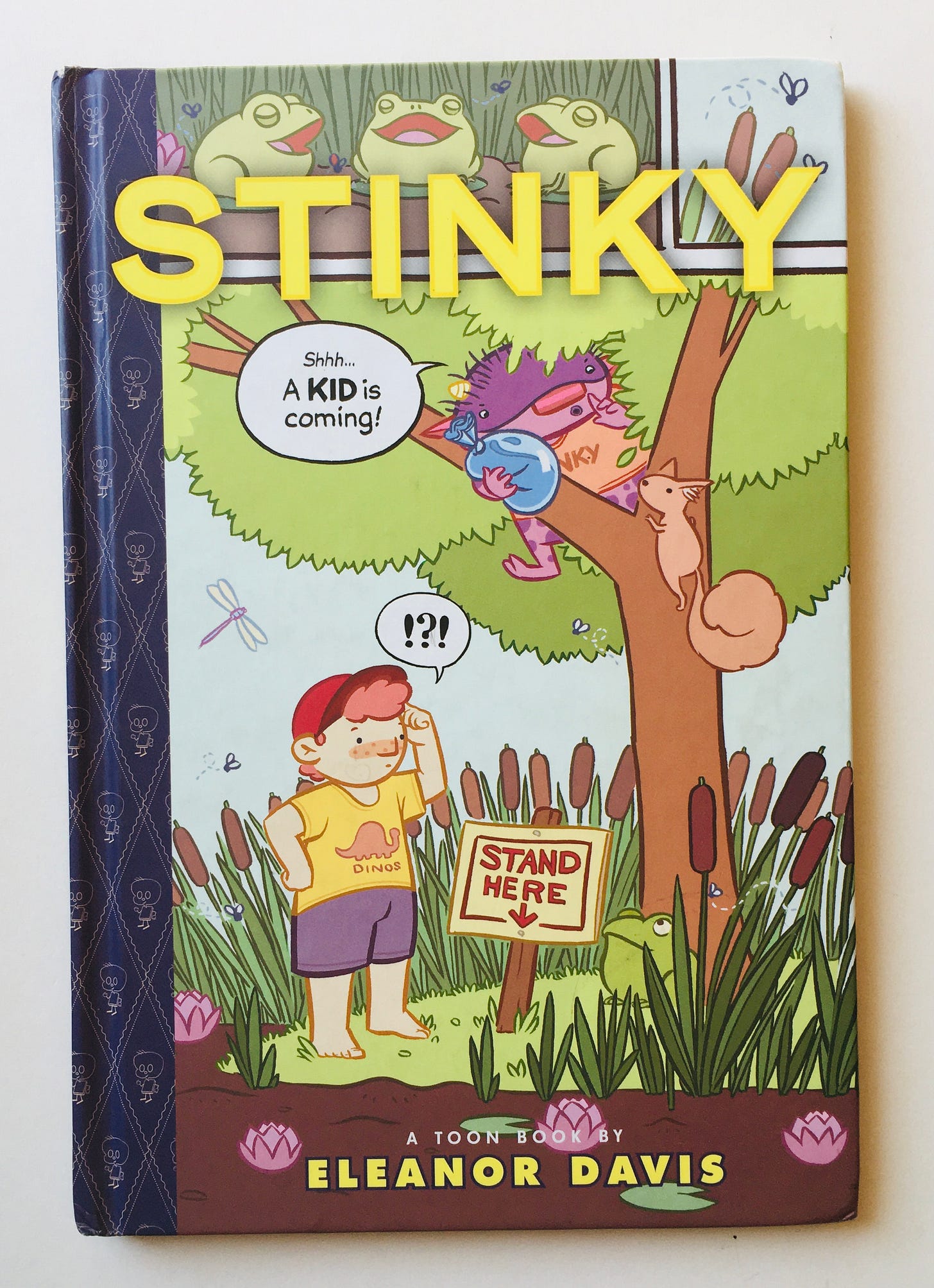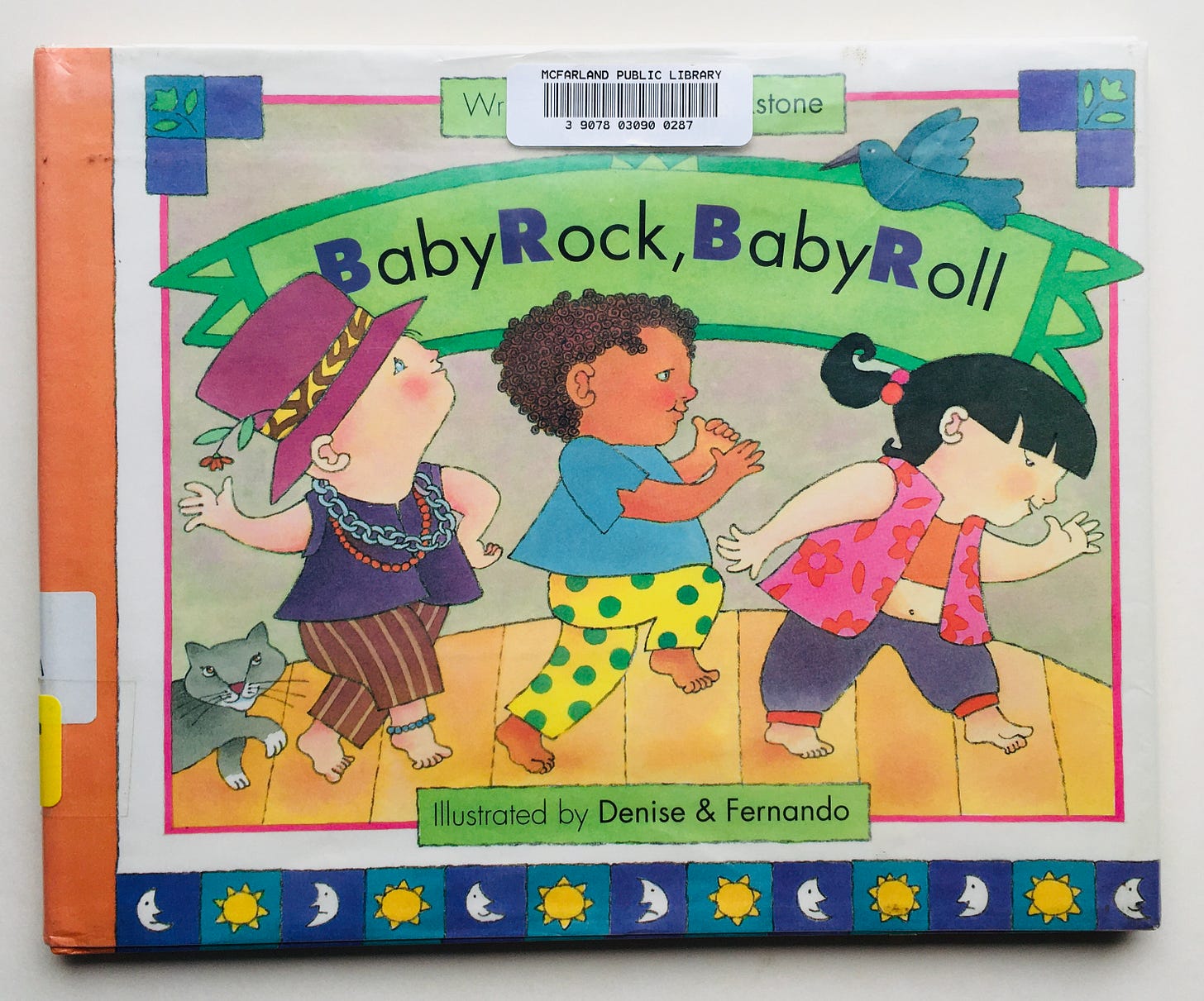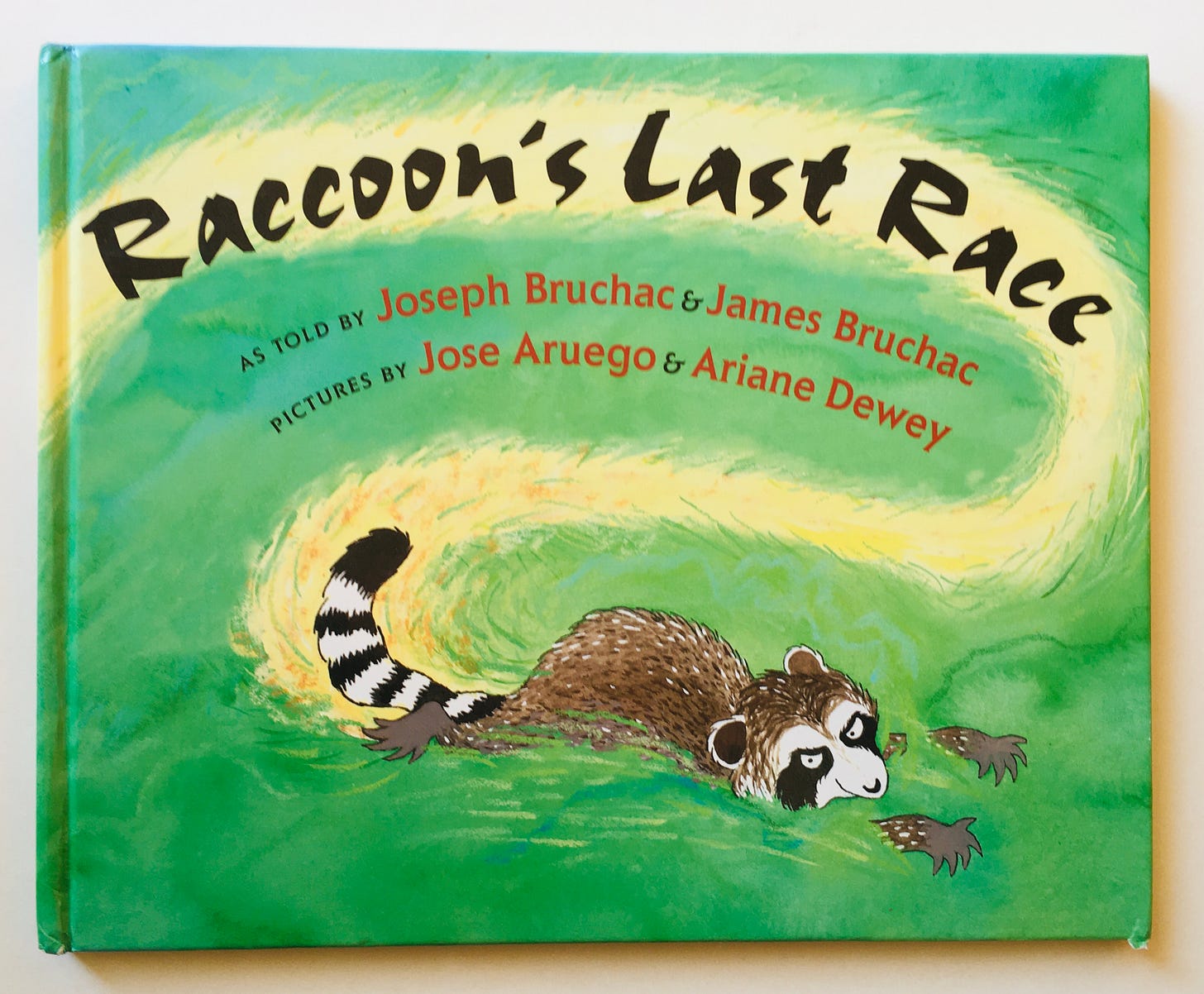Baby rock, baby read
Can we read? No. 57
Hi there.
Welcome, new subscribers! I’m so glad to have you here. If you are wondering what this newsletter is all about — who I am, what you will receive when, as well as the perks of being a paid subscriber, which gives you full access to everything I offer — hop on over to this page for more information.
Think you might be interested in a paid subscription but not sure? Here’s what “full access to everything I offer” actually means:
Every regular weekly issue on Wednesdays — that’s what you’re reading right now! (This is the only thing available to free subscribers.)
Notes From the Reading Nook on Tuesdays — short digests of some combination of what my family and I are currently reading, links of possible interest, topical mini booklists, answers to questions from you, and frequent subscriber-only giveaways
All special editions and Spotlight On issues — and there are some really juicy ones coming up as we head into the holidays and the darkest part of winter.
🎄 Part 1 of my special edition on Christmas drops next Wednesday and Part 2 the following week, which gives you plenty of time to get your hands on some fresh titles and enjoy them together ahead of December 24th and 25th. These are by far my biggest issues of the year, but you must be a paid subscriber to access them!
All (How) Can we read? issues — monthly deep dives into specific topics that give you practical, actionable ideas and support for raising readers
Access to my instant digital download, 100 Books to Build Your Library (a $5 value)
Personalized book recommendations at any time, for you or someone else
Paid subscriptions not only allow me to review more books for you, they keep this space free of ads and sponsors and make it possible for me to comp subscriptions to people who need them — those for whom the price is a barrier to entry, as well as teachers, librarians, and other under-funded and under-appreciated folks who work on behalf of children every day. (If any of this applies to you, hit reply on this message, let’s get you hooked up.)
Either way, I’m grateful for your time, attention, and space in your inbox, and hope you find value here.
Okay, let’s do this!
Hair Love by Matthew A. Cherry, illustrated by Vashti Harrison (2019)
Zuri’s hair has a mind of its own, so on a day when she wants it to be extra special, her dad offers to help her out. Together they try a handful of different styles but nothing feels quite right until — with a little help from a video tutorial on their tablet — her dad finally nails funky puff buns, “pretty, pretty, and so much fun,” just in time for her mother to walk through the door beneath a “Welcome Home, Mom” banner and into a big family hug.
If it doesn’t sound like there’s a lot to this story it’s because on the surface, there’s not. But what is there — pages of the experience of styling Black hair, and a father trying to help his daughter in this endeavor — is so rare it’s a story in and of itself. Why Zuri’s mother is absent (and why she is returning on this particular day) is never explained and doesn’t need to be — it’s the love between Zuri and her dad, and the tender way they problem-solve and perservere and finally succeed together that holds sway.
Harrison’s digital illustration are rich and engaging and showcase the plentiful emotion to be found when you hang in there, especially alongside someone you love.
Andrew's Bath by David McPhail (1984)
As a child who went through a years-long phase of vehemently protesting fully-submersed personal hygiene, I can completely relate to Andrew, a little boy who is “forever having trouble with his bath.” His parents — fed up with the water being too hot and then too cold, too shallow or too deep, amongst other things — decide Andrew is finally old enough to give himself a bath.
Of course, everything goes sideways. In his freedom, Andrew prepares a bath just the way he wants it — the perfect water temperature, a collection of his favorite toys and books, and, unexpectedly, a full-on menagerie of animals that joins him in the tub.
When his mother hears splashing, he blames the frog. When his father asks if he’s washing, Andrew replies that he can’t because the hippo is sitting on the soap. He can’t scrub behind his ears with the washcloth because the alligator ripped it “full of tooth holes,” nor can he wash his hair because the elephant drank the shampoo.
McPhail’s characteristic pen and watercolor illustration reveal the pure chaos happening in the tub (as well as Andrew’s parents’ increasingly weary expressions, which are fantastically honest), right up until the animals toss Andrew into the air in a towel to dry him off and he descends the stairs to ask if they might sleep with him tonight. (The response? “Only if they are quiet.”)
If bath time has ever been a struggle in your house (and if you say it never has I simply won’t believe you), this is the perfect antidote to the frustration on both sides. Grownups and children alike will find much to which to relate here, in the most engaging — not to mention endearing — way.
Stinky by Eleanor Davis (2008)
TOON Books is an imprint whose mission is to publish high-quality comics designed for children ages three and up. Billed as “easy-to-read” comics, that’s exactly what they are — making them perfect for beginning or emerging readers, but also for anyone who enjoys a well-done picture book, because every book in their catalog is, without exception, extremely well done.*
Stinky is no exception. Here we meet Stinky, a monster who lives with his pet toad, Wartbelly, and loves pickled things, possums, mud, slugs, and stinky smells. (He had me at “pickled things.”) He has one major problem in life: on the other side of the swamp where he lives is a town, full of children, who like to take baths and eat cake and apples. How appalling!
Stinky spends his life avoiding the town and the kids until one terrible day a kid comes strolling into the swamp. It turns out this brazen human child has made a treehouse in one of Stinky’s trees and — even worse — when Stinky tries to foil him at every turn, he enjoys it. At the epitome of his backfiring plan, Stinky falls into a pit — only to be saved, of course, by the imposter.
The nature of comics make the illustrations a foundational part of the story, and Davis — whose digital images here are vivid and, it must be said, adorable — does not disappoint. The reader sees and reads — and comes to understand through humor and a progressively warmer heart — not only the evolution of Stinky’s fear but the larger messages about open-mindedness, tolerance, and friendship. If you’ve never read comics for the youngest children, be sure to give this one a try.
*If the idea of this intrigues you, as well it should, I highly recommend any of the Benny and Penny titles by Geoffrey Hayes — there are six in the series and they are equal parts sweet and entertaining.
Baby Rock, Baby Roll by Stella Blackstone, illustrated by Fernando Azevedo and Denise Fraifeld (1997)
I am a big fan of Stella Blackstone — if you have a 2yo, run right out and get yourself a copy of Bear on a Bike; do not pass Go, do not collect $200, just trust me — and this title is a perfect example of how much there is to love about her work.
This is a simple rhyming book for babies and toddlers so there isn’t a narrative as much as, let’s say, a collection of baby-action and baby-images that show baby-life in all its glory. Three babies play and dance and eat and garden and throw snowballs and take baths only to finally relax and sleep.
Fraifeld’s and Azevedo’s warm colored pencil and watercolor illustrations do a wonderful job showing that everything here is constant change — seasons, clothing, emotions, facial expressions, and even, very subtly, day to night — offering lots to look at and talk about. And the sing-song rhythm is delightful to read aloud, as there is something really satisfying about a list of verbs marching to a beat:
Baby crawl,
Baby slip,
Baby ride.Baby jump,
Baby wave,
Baby hide.
Toddlers will love noticing the sly grey cat on every page and you will love to read this book again and again (or learn to 😉 ) because it’s one of those, and we should never deny our little ones the deep pleasure of this kind of repetition, especially not with a book this good.
Raccoon's Last Race by Joseph Bruchac and James Bruchac, illustrated by Jose Aruego and Ariane Dewey (2004)
If you come across any of the titles from this wonderful co-author, co-illustrator team, don’t even think about it — just snap them up. This title, along with How Chipmunk Got His Stripes and Turtle’s Race With Beaver, is based on the Abenaki heritage of Joseph Bruchac and his son, James, and — like many fables and pourquoi tales (a story that explains why something is the way it is) — is told in such a way that the message comes through loud and clear without being overtly didactic, tedious, or heavy handed. (That might not sound all that remarkable until you take a look at what’s currently being published for children and realize that we’ve somehow arrived at a point where the moral of a story seems to trump the actual enjoyment of the story, which is not only backwards but also ineffective and uninteresting.)
Here the reader meets Azban the raccoon — a competitive guy with a long tail and a penchant for running fast. Every time he wins a race against his fellow animals, he lacks the graciousness of a good winner, instead taunting his competitor to the point where no one is willing to race him anymore. Does this stop him? No. Instead he begins to play tricks on everyone around him, including Grandfather Big Rock, who insists that he doesn’t want to race Azban or even travel at all, which only leads to Azban to push Big Rock down a steep hill.
At first Azban is pleased with his actions, disrespectful and wicked as they are, but as Big Rock picks up speed — going faster and faster down the hill, “Ka-boom! Ka-boom!” — Azban who pays the price when he trips, falls right in front of Big Rock, and is flattened by the grandfather’s enormous weight.
Unsurprisingly, none of the animals whom Azban has previously provoked will help him — save for a lone ant, who makes Azban promise to always be his friend if he helps him. Azban agrees and the ant gathers his village, working together to pull the squashed raccoon — rendered fantastically by Aruego’s and Dewey’s pen and watercolor illustrations — almost, but not entirely, back into shape.
Does Azban appreciate this? Does he keep his promise?
What do you think?
This amusing and eternally pleasing story emphasizes the importance of keeping one’s promises, warns against being a jerkwad, and explains why raccoons remain the “short, squatty animals” they are to this day (I love this description). Plus, it’s great fun to read.
That’s all for today, you lovely people. Thanks for being here.
(And if you know someone who might like this newsletter, please pass it on!)
Sarah
Some of my previous reviews of books for babies and toddlers
The Little Band by James Sage (issue No. 2)
Quick as a Cricket by Audrey Wood (issue No. 4)
Please, Puppy, Please by Spike Lee and Tanya Lewis Lee (issue No. 5)
Wondering why I’m highlighting titles for the tiny crowd? See last week’s issue No. 56 for a brief explanation.
Still looking for something to read ahead of Thanksgiving next week?
I got your back:







